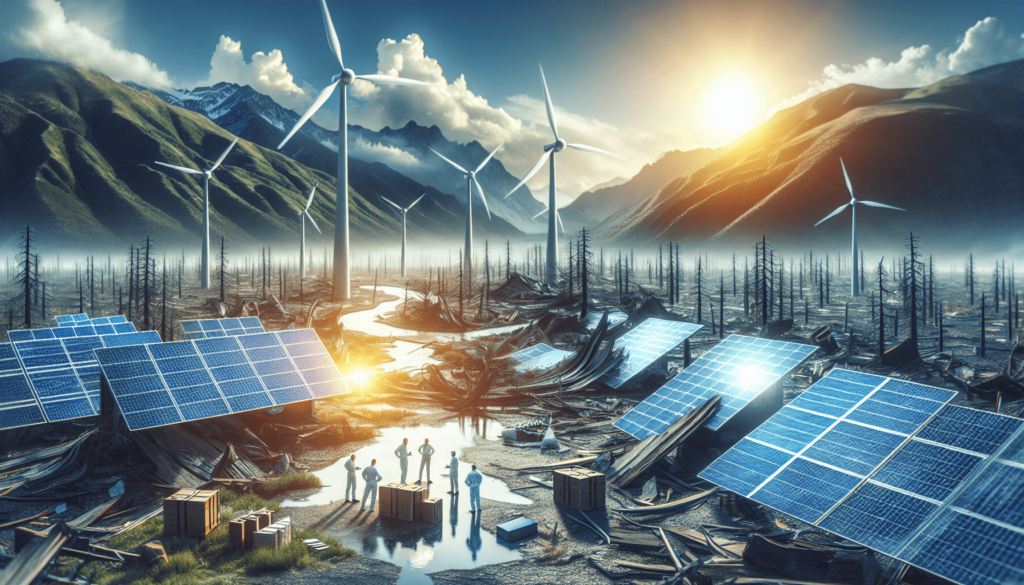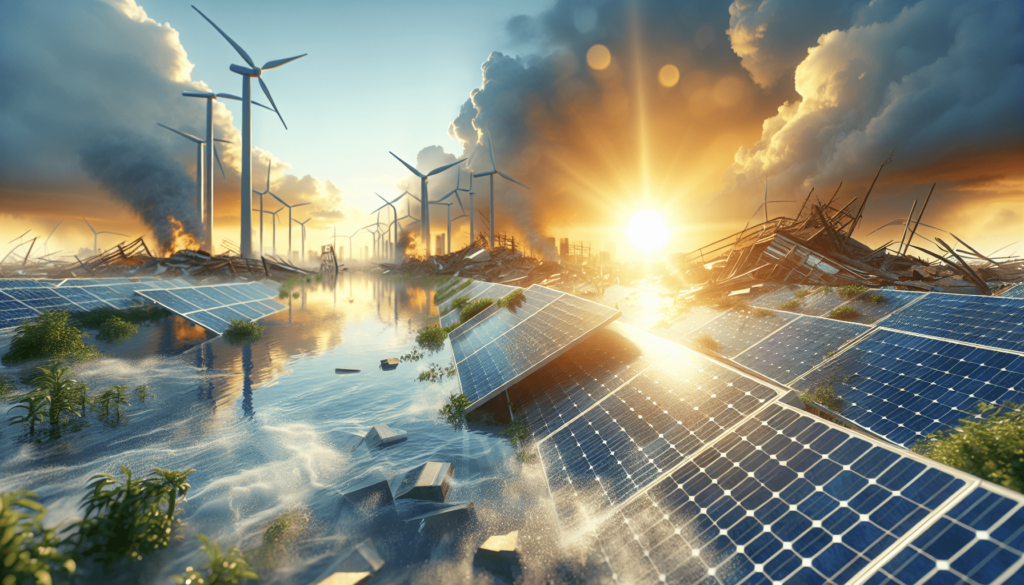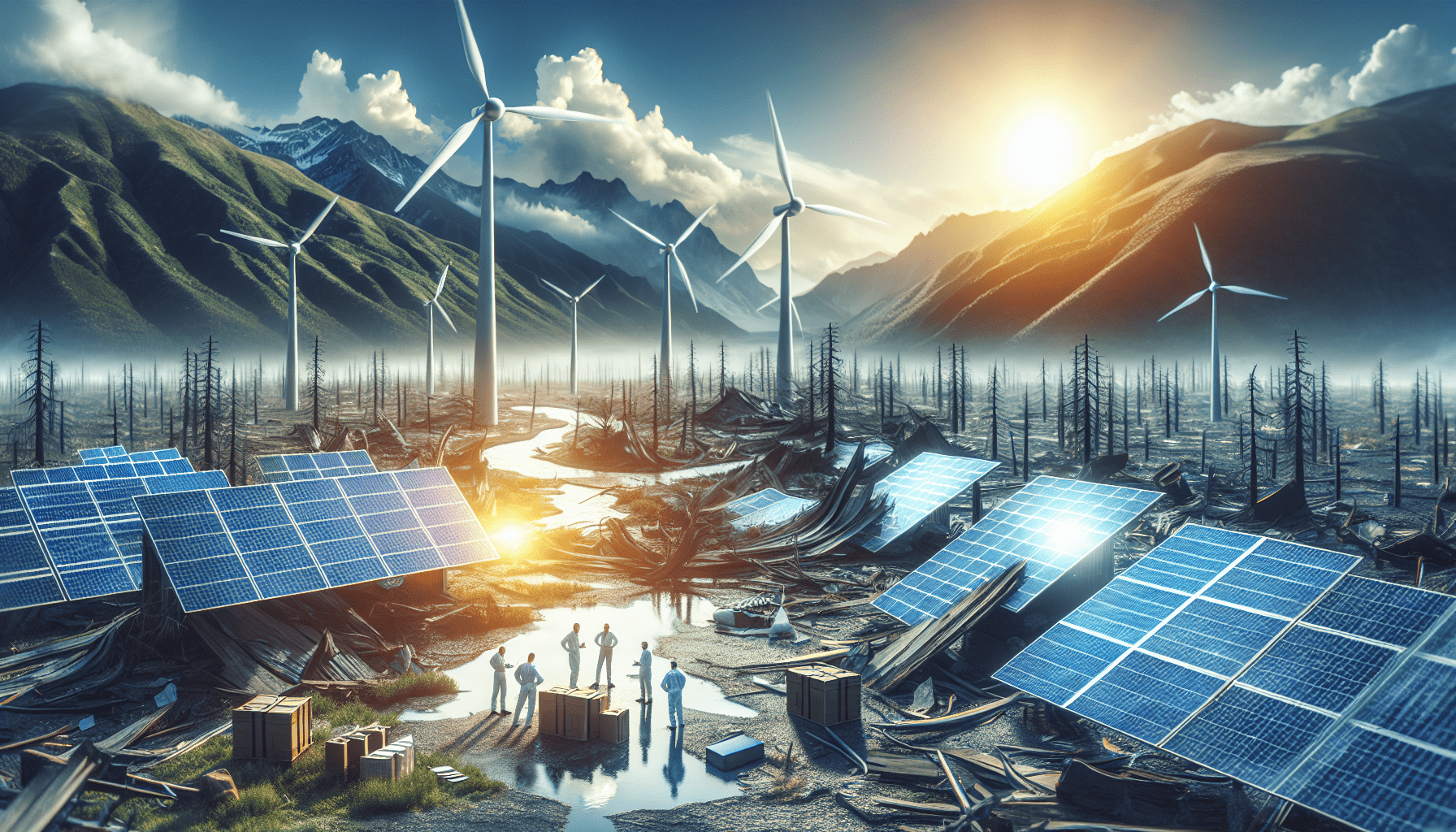In the aftermath of a disaster, the importance of a swift and efficient recovery cannot be overstated. While traditional sources of energy may be compromised or damaged, renewable energy emerges as a reliable and resilient solution. With the capability to generate power from sources such as wind, solar, and hydro, renewable energy plays a pivotal role in disaster recovery efforts. This article explores the invaluable contribution of renewable energy in rebuilding communities, ensuring access to electricity, and promoting long-term sustainability.

Overview of Disaster Recovery
Definition of disaster recovery
Disaster recovery refers to the process of restoring and rebuilding essential services, infrastructure, and systems following a disaster. It involves the coordination of efforts to recover from the impacts of natural or man-made disasters such as hurricanes, earthquakes, floods, or wildfires. The primary goal of disaster recovery is to minimize the disruption caused by the disaster and to facilitate the swift and efficient restoration of affected areas.
Importance of disaster recovery
Disaster recovery is crucial for ensuring the resilience and sustainability of communities and economies in the face of disasters. It plays a vital role in mitigating the impact of disasters on human life, critical infrastructure, and the environment. By having effective disaster recovery plans in place, communities can minimize the loss of life, accelerate the recovery process, and enhance their ability to withstand future disasters.
Types of disasters
Disasters can be broadly categorized into natural and man-made disasters. Natural disasters include events such as hurricanes, earthquakes, floods, tsunamis, and wildfires. Man-made disasters, on the other hand, include incidents such as industrial accidents, terrorist attacks, cyber-attacks, and pandemics. Both types of disasters can have severe repercussions on the affected area, making effective disaster recovery efforts essential in mitigating their impacts.
Introduction to Renewable Energy
Definition of renewable energy
Renewable energy refers to energy derived from naturally replenishable sources that are virtually inexhaustible and have minimal impact on the environment. It is harnessed from sources such as sunlight, wind, water, geothermal heat, and biomass. Unlike fossil fuels, which are finite and contribute to climate change, renewable energy sources provide a sustainable and clean alternative to meet our energy needs.
Types of renewable energy sources
There are various types of renewable energy sources that can be utilized for electricity generation and meeting energy demands. These include solar energy, wind energy, hydroelectric power, geothermal energy, and biomass. Each source has its own unique characteristics, advantages, and potential applications, making them suitable for different geographical regions and energy requirements.
Advantages of renewable energy
Renewable energy offers numerous advantages over traditional fossil fuels. Firstly, it significantly reduces greenhouse gas emissions and contributes to mitigating climate change. Secondly, it provides a decentralized and distributed energy generation system, reducing the reliance on centralized power plants and increasing energy security. Additionally, renewable energy sources are virtually inexhaustible and offer long-term cost stability, making them economically viable and sustainable alternatives.
Challenges in Disaster Recovery
Lack of power supply
One of the significant challenges faced in disaster recovery is the lack of power supply in affected areas. Disasters often lead to widespread power outages, making it challenging to carry out emergency operations, provide medical services, and restore critical infrastructure. Without a reliable power supply, the recovery efforts are hindered, and the affected communities are left vulnerable to further risks and hardships.
Infrastructure damage
Disasters cause extensive damage to infrastructure, including buildings, roads, bridges, and utility networks. This infrastructure damage poses a significant challenge in disaster recovery, as it requires substantial time, resources, and expertise to repair and rebuild. The absence of functional infrastructure slows down the recovery process and limits the capacity to restore vital services and facilities.
Environmental concerns
Disasters can have severe environmental impacts, including pollution, deforestation, habitat destruction, and the release of toxic substances. These environmental concerns further complicate the disaster recovery process, as they require specialized expertise and resources to mitigate and restore affected ecosystems. Ineffective environmental management in disaster recovery can exacerbate the environmental damage and hinder the long-term sustainability and resilience of the affected areas.
Benefits of Renewable Energy in Disaster Recovery
Reliable and sustainable power source
Renewable energy provides a reliable and sustainable power source in disaster recovery efforts. Solar energy and wind energy, for example, can be harnessed through photovoltaic panels and wind turbines to generate electricity even in the absence of the traditional power grid. This enables the provision of critical services, such as lighting, communication, and medical equipment, ensuring the well-being and safety of the affected communities.
Reduced reliance on fossil fuels
By incorporating renewable energy in disaster recovery, there is a reduced reliance on fossil fuels, which are often in limited supply during and after disasters. Fossil fuels not only contribute to environmental pollution but can also be challenging to transport and distribute in a disrupted and damaged infrastructure. Transitioning to renewable energy sources allows for a more sustainable and efficient energy supply, minimizing the dependence on fossil fuels and reducing the associated logistical challenges.
Quicker restoration of basic services
The use of renewable energy sources enables quicker restoration of basic services in disaster-affected areas. Microgrids, for instance, can be established to provide localized power supply, ensuring that essential facilities such as hospitals, emergency shelters, and water treatment plants have access to electricity. This accelerates the recovery process by facilitating the resumption of critical operations and services, improving the quality of life for the affected population.
Lower carbon emissions
Another significant benefit of renewable energy in disaster recovery is the reduction of carbon emissions. Fossil fuel-based power generation is a major source of greenhouse gas emissions, contributing to climate change. By utilizing renewable energy sources, the carbon footprint associated with disaster recovery operations can be significantly reduced. This helps mitigate the long-term impacts of climate change and promotes a more sustainable and environmentally friendly recovery process.

Applications of Renewable Energy in Disaster Recovery
Off-grid renewable energy systems
Off-grid renewable energy systems, such as standalone solar panels or wind turbines, can be deployed in disaster-affected areas to provide independent and self-sustained power supply. These systems can be installed in remote locations or areas without access to the traditional power grid, ensuring that essential services and facilities have a reliable source of electricity during the recovery phase. Off-grid systems can also be used to power temporary shelters, communication networks, and emergency equipment.
Microgrids
Microgrids are localized power grids that can operate independently or in conjunction with the main power grid. In disaster recovery, microgrids play a vital role in ensuring the continuity of essential services and critical infrastructure. By integrating renewable energy sources, such as solar and wind, into microgrid systems, the affected areas can maintain a reliable power supply even during power outages or disruptions in the main grid. Microgrids also provide an opportunity for communities to transition to a more decentralized and sustainable energy infrastructure.
Solar-powered water purification
Access to clean and safe drinking water is crucial in disaster-affected areas. Solar-powered water purification systems utilize solar energy to power the filtration and purification processes, ensuring the availability of clean water for drinking, cooking, and sanitation purposes. These portable and easy-to-use systems can be quickly deployed in emergency situations, helping to address one of the immediate needs of disaster-affected communities.
Wind-powered emergency communication
Effective communication is essential in disaster recovery to coordinate relief efforts, disseminate information, and ensure the safety of the affected population. Wind-powered emergency communication systems utilize wind turbines to generate the necessary power for communication equipment, such as radios or satellite phones. These systems provide a reliable and sustainable means of communication, even in areas without access to electricity or a functional communication network.
Case Studies
Japan: Fukushima disaster
The Fukushima disaster in 2011, caused by a massive earthquake and subsequent tsunami, highlighted the importance of renewable energy in disaster recovery. The nuclear power plant meltdown led to power outages and widespread contamination, severely impacting the region. To facilitate the recovery process, Japan invested heavily in renewable energy sources, particularly solar energy. The deployment of solar panels not only provided a reliable power supply but also contributed to the long-term sustainability and resilience of the affected areas.
Puerto Rico: Hurricane Maria
After Hurricane Maria struck Puerto Rico in 2017, the island faced a devastating power outage that lasted for months. The destruction of the electrical grid highlighted the need for alternative and sustainable energy sources. In response, Puerto Rico increased its focus on renewable energy, particularly solar energy and battery storage systems. The incorporation of renewable energy technologies not only provided a reliable and resilient power supply but also allowed for quicker restoration of vital services and facilities.
California: Wildfires
The widespread wildfires in California have posed significant challenges for disaster recovery efforts. The destruction of power lines and infrastructure has resulted in prolonged power outages and disrupted essential services. To address these challenges, California has been actively promoting the use of renewable energy and microgrids. These decentralized power systems, incorporating solar energy and energy storage, can operate independently and provide reliable electricity to critical facilities and communities during and after wildfires, thereby enhancing the resilience of the affected areas.
Government Initiatives and Policies
Incentives for renewable energy adoption
Many governments around the world have implemented various incentives to promote the adoption of renewable energy. These incentives can include tax credits, grants, feed-in tariffs, and subsidies for renewable energy projects. By offering these incentives, governments encourage individuals, businesses, and communities to invest in renewable energy technologies, facilitating their integration into disaster recovery plans and enhancing overall sustainability.
Funding for renewable energy projects
Governments also provide funding opportunities for renewable energy projects, particularly in the context of disaster recovery. This financial support aims to accelerate the implementation of renewable energy technologies in affected areas, enabling the provision of reliable power supply and vital services. By allocating dedicated funds for renewable energy projects, governments demonstrate their commitment to sustainable and resilient recovery efforts.
Regulations promoting renewable energy
Regulatory frameworks and policies play a crucial role in promoting renewable energy in disaster recovery. Governments can implement regulations that require a certain percentage of energy to be sourced from renewable sources or provide incentives for utilities to invest in renewable energy infrastructure. These regulations create a supportive environment for renewable energy adoption, encouraging collaboration between public and private sectors in advancing clean and sustainable energy solutions.
International Cooperation and Support
United Nations’ Sustainable Development Goals
The United Nations’ Sustainable Development Goals (SDGs) provide a global framework for sustainable development and disaster recovery. Several SDGs are directly linked to renewable energy and disaster resilience, including Goal 7 (Affordable and Clean Energy), Goal 9 (Industry, Innovation, and Infrastructure), and Goal 11 (Sustainable Cities and Communities). International cooperation and support through the SDGs enable countries to share best practices, resources, and knowledge in adopting renewable energy in disaster recovery efforts.
Global initiatives for renewable energy
Numerous global initiatives and organizations are dedicated to promoting renewable energy in disaster recovery. Programs like the International Renewable Energy Agency (IRENA) work towards advancing the use of renewable energy worldwide, including in disaster-prone areas. These initiatives provide technical assistance, capacity building, and knowledge sharing to support countries in integrating renewable energy into their disaster recovery strategies.
Partnerships for disaster recovery and renewable energy
Partnerships between governments, non-governmental organizations (NGOs), academic institutions, and private sector entities play a crucial role in advancing renewable energy in disaster recovery. Collaborative efforts, such as public-private partnerships and research collaborations, help leverage expertise, resources, and funding towards implementing sustainable and resilient energy solutions. These partnerships foster innovation, facilitate knowledge exchange, and support the implementation of renewable energy technologies in disaster recovery.
Technological Innovations
Energy storage solutions
Energy storage technologies play a critical role in enabling the effective integration of renewable energy in disaster recovery. Batteries, flywheels, and pumped hydro storage systems provide the means to store excess energy generated from renewable sources and use it during periods of high demand or when the renewable sources are not available. Energy storage solutions ensure uninterrupted power supply, enhance grid stability, and optimize the utilization of renewable energy resources.
Smart grid systems
Smart grid systems enable the efficient transmission and distribution of electricity, ensuring a reliable and resilient energy infrastructure in disaster recovery. By incorporating advanced monitoring, communication, and control technologies, smart grids facilitate the integration of renewable energy sources, improve system reliability, and enable demand response mechanisms. These systems enhance the overall efficiency and effectiveness of disaster recovery operations, contributing to sustainable and resilient recovery efforts.
Remote sensing and monitoring technologies
Remote sensing and monitoring technologies play a crucial role in disaster recovery and renewable energy integration by providing real-time data and insights. Satellite imagery, drones, and other remote sensing techniques enable the assessment of damages, identification of suitable locations for renewable energy projects, and monitoring of energy generation and distribution. These technologies support evidence-based decision-making, enhance situational awareness, and ensure effective planning and implementation of renewable energy solutions in disaster recovery.
Future Outlook
Increasing role of renewable energy in disaster recovery
The role of renewable energy is expected to grow significantly in disaster recovery efforts in the future. As the impacts of climate change intensify and the frequency and severity of natural disasters increase, there is a greater need to adopt sustainable and resilient energy solutions. Renewable energy offers the potential to address the energy challenges faced in disaster recovery, providing reliable power supply, reducing carbon emissions, and enhancing overall resilience.
Advancements in renewable energy technologies
Advancements in renewable energy technologies are poised to further enhance their applicability and effectiveness in disaster recovery. Continued research and development efforts are focused on improving the efficiency, scalability, and affordability of renewable energy systems. Innovations in energy storage, solar photovoltaics, wind turbines, and other renewable energy technologies will contribute to their wider adoption and integration into disaster recovery plans.
Integration of renewable energy in disaster response planning
The integration of renewable energy into disaster response planning will become a fundamental aspect of resilience-building efforts. Governments and organizations need to incorporate renewable energy considerations into their disaster preparedness and response strategies. By proactively evaluating the energy needs, vulnerabilities, and opportunities of disaster-prone regions, they can develop comprehensive plans that prioritize the integration of renewable energy and ensure a sustainable and resilient recovery process.

